The August 2016 Challenge
Revisit any Commuter Challenge of the last ten years.
Do you wish you had spent a little more time on the final mix of that one song? Remix it now. Do you wish you had used proper tools to make that one illustration, instead of a ball point pen? Draw a better one now. Do you wish you had written a poem that one month instead of binge-watching TV? Write it now. Are you currently kicking yourself for never having participated in the Commuter Challenge, ever? Pick a challenge now — any challenge — and do it.
Do more than one. Do as many as you want. Do anything at all.
The Results
Ryan Finholm
Revisiting December 2008 (“write some New Year’s resolutions”):
Revisiting December 2008 (“write some New Year’s resolutions”):
Revisiting March 2010 (“write a sonnet using words with the same initial letter”):
Revisiting March 2010 (“write a sonnet using words with the same initial letter”):
Revisiting August 2008 (“construct a writing system”):
Revisiting August 2008 (“construct a writing system”):
I called this writing system “Slur”. The original intention was to pare down the alphabet to as few letters as possible while maintaining as much comprehensibility as possible. Part of my inspiration with this was my exposure to Tagalog, a language which occasionally uses the letters F and P interchangeably, and also sometimes uses the letters B and V interchangeably.
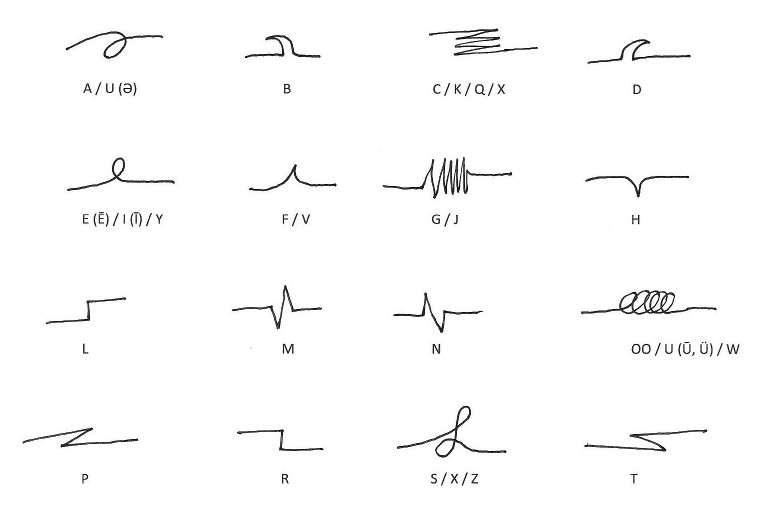
The alphabet, spelling and syntax of the modern English language is inundated with arbitrary exceptions, quirky artifacts and unnecessary inefficiencies based on archaic and obsolete conventions: Why “I before E except after C”? For that matter, why either of those when all instances could be more effectively replaced by a long E or long I? Why both a C and a K? Why should there be a Q at all, when we have K and W? Why should there be an X at all, when all usages could easily be spelled phonetically with other letters? Why not get rid of silent letters? Why not dispense with most punctuation? I approached this new alphabet with that mindset.
After dismissing the first half-dozen or so (arguably) superfluous letters from the modern English alphabet, it becomes increasingly difficult to bring the total letter count down any further… unless you are not particularly concerned about diction. That is where the slurring comes in. The schwa takes on more responsibilities than it’d had previously, mushing the ahs, ehs, ihs and uhs into one dull vowel, and helping to complement long vowels; since the same symbol is used for the y, the long e, and the long i, “ride” is distinguished from “reed” by putting the schwa in front of the long vowel (which is how it works phonetically anyway if you break it into fractions of syllables).
I could go on and on about word structures and lip/tongue/teeth movements during speech, but it is probably best to avoid scrutinizing Slur too closely. I’d like to admit that one big failure of this system was my inability to meld “TH” and “SH” in a more elegant way. I also noticed how similar some of my symbols are to Sam Bleckley’s Commuter Challenge submission, which is coincidence – in creating a set of cursive symbols that can flow in a single line while avoiding symbols that resemble cursive English alphabet letters, I guess there are a few simple options that would naturally tend to happen, and I decided to stick with what I’d chosen 8 years ago instead of trying to design something entirely new.
I also added unnecessary cryptographic components to this alphabet because that seemed somewhat intrinsic to the spirit of the endeavor, and because I thought it would be fun. To make slur more likely to confound a lay reader, one should write in slur using the non-dominant hand. Also, the only “punctuation” in slur is any actual random word in English, which should be placed at the end of each sentence.
Sample text:

“All human beings are born free and equal in dignity and rights. They are endowed with reason and conscience and should act towards one another in a spirit of brotherhood.”
Revisiting October 2008 (“compose 1–3 minutes of scary music”):
Revisiting October 2008 (“compose 1–3 minutes of scary music”):
Bedsheet Ghosts (2:14)
Revisiting July 2007 (“create an accompaniment to a public domain work”):
Revisiting July 2007 (“create an accompaniment to a public domain work”):
Original: a scene from “Plan 9 from Outer Space”.
Real Reel to Reel
Revisiting July 2016 (“create a work that includes words, music, and images”):
Revisiting July 2016 (“create a work that includes words, music, and images”):
video for Good Luck Charm
Brian Raiter
Revisiting August 2006 (“write a sonnet about superconductors”):
Revisiting August 2006 (“write a sonnet about superconductors”):
In the Superconductor Research Laboratory
Revisiting Feburary 2007 (“write a cogent paradelle”):
Revisiting Feburary 2007 (“write a cogent paradelle”):
Solitaire
Revisitng August 2008 (“construct a writing system”):
Revisitng August 2008 (“construct a writing system”):
Consonance
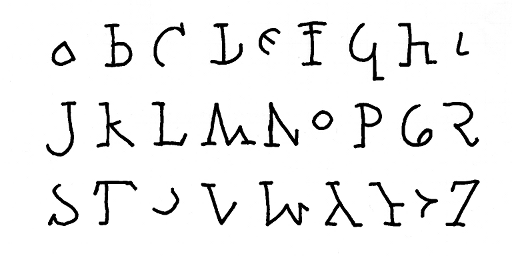
This image shows the alphabet of Consonance. It uses the same 26 letters as the modern Roman Alphabet. There are no separate capitals or lowercase letters. Note that vowels are half as tall as consonants, and can be written above the baseline, depending on aesthetic choice. The letter Y has two forms, depending on whether it is being used as a consonant or a vowel.
English words are written with their normal spelling in this script. However, diphthongs are written with the two letters “combined”, taking advantage of their smaller size to fit them into the space of one letter. Likewise, silent letters have to fit into the empty space of their neighbor. Consonantal clusters like BR are handled similarly. All consonants have extra whitespace, typically in the upper right, to make room for such combinations. (Admittedly this can sometimes obscure the correct order of the letters.) For a handful common bigrams like TH, CK, QU, etc., the letters are actually combined into a single glyph.

In the larger sample text below, for example, you can see how the letters pile up in the second syllable of “conscience”, reflecting the fact that although the second syllable has twice as many letters as the first, both syllables are equally long when spoken.
Sample texts:

“The quick brown fox jumps over the lazy dog.”

“All human beings are born free and equal in dignity and rights. They are endowed with reason and conscience and should act towards one another in a spirit of brotherhood.”
Revisiting April 2011 (“write a slant rhyme movie poem”):
Revisiting April 2011 (“write a slant rhyme movie poem”):
Revisiting August 2013 (“produce a diagram involving minerals”):
Revisiting August 2013 (“produce a diagram involving minerals”):
Solar System Elemental Composition
Brian Timares
Revisiting February 2013 (“create a half-black half-white illustration”) and June 2016 (“create a visual artwork in a medium you’ve never used before”):
Revisiting February 2013 (“create a half-black half-white illustration”) and June 2016 (“create a visual artwork in a medium you’ve never used before”):
rubber block print
Revisiting January 2011 (“create an original artwork and use it as a postcard”):
Revisiting January 2011 (“create an original artwork and use it as a postcard”):
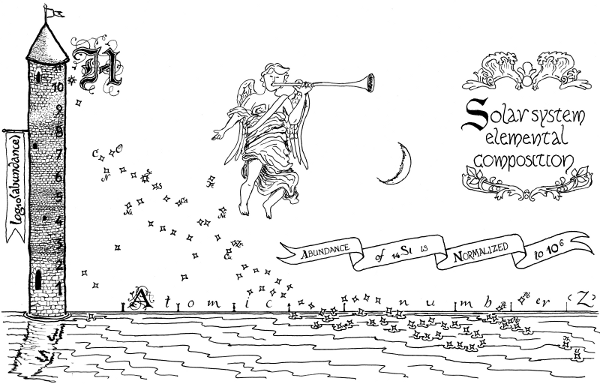
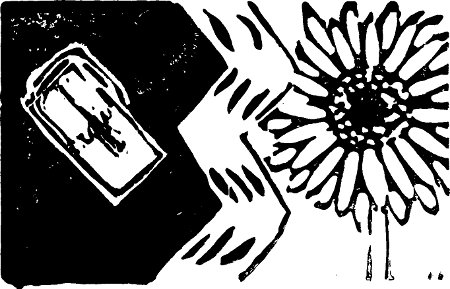
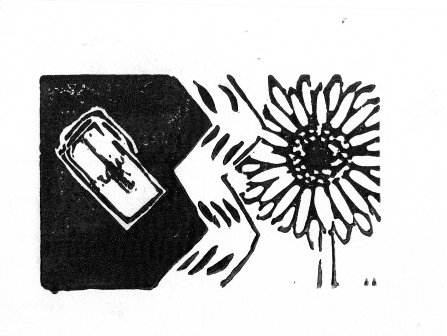
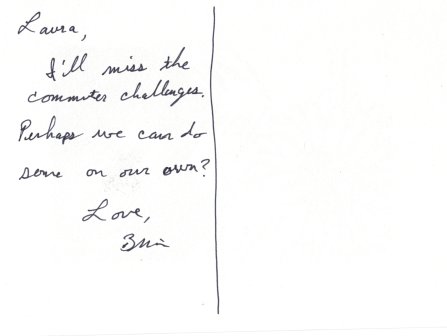
Wow, I’m impressed. I did 1 that matched 3 challenges, you both did 5 challenges!
Very nice work, although I’m not checking ‘Slur’ for accuracy!
by Brian Timares — 1 September 2016 @ 01:08
Brian: We did so many only because we have so many regrets.
Seriously, though, so happy to see your contributions land in my inbox at the last minute. I was hoping there would be at least one old-timer who’d return for a last submission!
by Brian — 1 September 2016 @ 01:16
Some quick notes about my entries:
August 2006: So the very first Commuter Challenge was to write a sonnet about superconductors, and I was very happy with my submission. Until 5 years later, when I suddenly discovered that I had gotten the pronunciation of “interstices” wrong. I thought the primary stress was on the 3rd syllable, like in “intersection”. Turns out it’s on the 2nd syllable, like in “internalize”. Unfortunately that word appears in the second half (the sestet) of the sonnet, which is supposed to be very metrically regular, to evoke the crystalline regularity and stasis of the world of the electrons in the superconductor. So I had to use this opportunity to reword the sonnet to fix the meter.
Feburary 2007: This is the only Commuter Challenge left that I never produced a submission for. (I also failed to submit anything in January 2007, but I remedied that in the “Amnesty Month” challenge of January 2010. The paradelle, my bete noir. I managed a bit of form/content interplay, but I’m afraid my submission for this one is definitely below the standard set by Ryan and Catherine’s entries. But I don’t care. I’ve written a valid paradelle. My slate is finally wiped clean.
August 2008: This was one I felt compelled to do a proper submission for. My actual submission was really lame, which was all the more embarrassing because the challenge was originally my idea. I had been excited to work on the challenge at first, but I never liked any of the ideas I came up with at the time. And so I had been forced to fall back on making something intentionally unpleasant to read. This submission is close to what I had tried to come up with back in 2008, and I’m pretty happy with how it looks.
April 2011: While I like the poem I originally submitted for this challenge, while writing it I completely forgot about the secondary constraint, that it had to refer to a movie. So I submit this poem now, to bring myself into full compliance with the requirements of the challenge. It’s completely unlike the one I originally submitted, but I’m very happy that my last Commuter Challenge entry includes a brand new sonnet. I always had fun writing sonnets for the Challenge.
August 2013: Same deal. I had two perfectly good original submissions that both completely missed the secondary constraint. No good reason for it, other than my own forgetfulness. This time my replacement entry is in the same style as my original submission, but explicit references to metals (and silicon) brings me in line with the mineral constraint. I quite enjoyed making this diagram, in fact. If I had had time I would have made another one, about “chondrules” (granules found in meteorites).
In fact, had I had more time I would have revisited twice as many challenges as I did here. I only got halfway down my list before I ran out of time. There are a few other entries that I phoned in that deserve a proper submission, there are several entries that I could do a much better job on with all the experience I have now, and there are others that I just ran out of time on and had to turn in half-finished …
Just like this one.
by Brian — 1 September 2016 @ 02:25
This month’s Challenge was an opportunity to redeem myself a little for my flakiness in the early years of the Commuter Challenge. With this group of entries, I have filled in all my blank spots and successfully submitted something for every Commuter Challenge. I would have strongly [STRONGLY] preferred to re-do some of my other sub-par submissions, and especially my sub-sub-par submissions, some of which are extremely embarrassing to me, but I prioritized getting this much done as possible and ran out of time to attempt improvements on previous works.
Most of my entries this month are pretty self-explanatory, so I’ll just comment on the videos.
The entry for the July 2007 “create an accompaniment to a public domain work” Commuter Challenge is a song to accompany a scene from “Plan 9 from Outer Space”. “Plan 9 from Outer Space” is occasionally referred to as the worst movie of all time (an exaggeration), and it is currently in the public domain and available for download at Archive.org . I’d been looking into doing my own “Bad Lip Reading” project for a new Jerkatorium song, and in order to avoid some of the copyright/C&D issues the Bad Lip Reading folks encountered, I figured I’d look into footage in the public domain. This search involved me skimming through lots of streaming public domain footage with the sound off, looking for scenes lasting three minutes or more with some good facial closeups. I eventually came to Plan 9, and though I didn’t see anything particularly promising for a Bad Lip Reading project, I did find the opposite: those military guys hanging out, silently listening to a reel-to-reel tape player for 99 seconds. So I decided to make a 98-second song about a reel-to-reel tape player. The lead vocals were performed by Chumpy, whose help with the mixing and mastering was also utterly invaluable as always.
For my final entry, I decided I needed to re-do the video for the July 2016 Challenge. After I’d posted the original ‘How to write and record a Jerkatorium song’ video on YouTube last month, Chumpy created some quick Logic Pro X tutorial videos for me to watch. The tutorials were extremely helpful, and they showed me that instead of taking advantage of its many amazing features, I was using Logic Pro X as if it were two circa 1984 Radio Shack cassette recorders strapped together. My Logic Pro X advice in that first video was terrible, and I wanted to get it off the internet as soon as possible without messing with the spirit of the Commuter Challenge, so I re-did the video (much shorter now, and much more general, and without any Logic advice) and deleted the old one. The new video was a quick, last-minute effort – if you look at the time stamp in the corner of the lyric sheet, you can see that I was still preparing the presentation (not even recording it yet) by 10:50pm on the date of deadline. I would have preferred a chance to do a better take, but I ran out of time.
by RyanF — 1 September 2016 @ 12:14